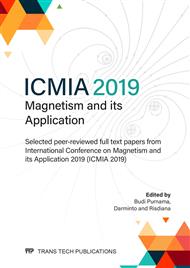[1]
Dawood S and Sen T K 2014 Review on Dye Removal from Its Aqueous Solution into Alternative Cost Ef- fective and Non-Conventional Adsorbents.
DOI: 10.17303/jce.2014.105
Google Scholar
[2]
Mufti N, Munfarriha U, Fuad A and Diantoro M 2016 Synthesis and photocatalytic properties of Fe3O4@TiO2 core-shell for degradation of Rhodamine B AIP Conference Proceedings vol 1712.
DOI: 10.1063/1.4941892
Google Scholar
[3]
Wu Q, Feng C, Wang C and Wang Z 2013 A facile one-pot solvothermal method to produce superparamagnetic graphene–Fe3O4 nanocomposite and its application in the removal of dye from aqueous solution Colloids Surf. B Biointerfaces 101 210–4.
DOI: 10.1016/j.colsurfb.2012.05.036
Google Scholar
[4]
Singh N B, Nagpal G, Agrawal S and Rachna 2018 Water purification by using Adsorbents: A Review Environ. Technol. Innov. 11 187–240.
DOI: 10.1016/j.eti.2018.05.006
Google Scholar
[5]
Es'haghzade Z, Pajootan E, Bahrami H and Arami M 2017 Facile synthesis of Fe3O4 nanoparticles via aqueous based electro chemical route for heterogeneous electro-Fenton removal of azo dyes J. Taiwan Inst. Chem. Eng. 71 91–105.
DOI: 10.1016/j.jtice.2016.11.015
Google Scholar
[6]
Tartaj P, González-Carreño T and Serna C J 2003 Magnetic Behavior of γ-Fe 2 O 3 Nanocrystals Dispersed in Colloidal Silica Particles J. Phys. Chem. B 107 20–4.
DOI: 10.1021/jp0260898
Google Scholar
[7]
Huang B, Qi C, Yang Z, Guo Q, Chen W, Zeng G and Lei C 2017 Pd/Fe 3 O 4 nanocatalysts for highly effective and simultaneous removal of humic acids and Cr(VI) by electro-Fenton with H 2 O 2 in situ electro-generated on the catalyst surface J. Catal. 352 337–50.
DOI: 10.1016/j.jcat.2017.06.004
Google Scholar
[8]
Mufti N, Atma T, Fuad A and Sutadji E 2014 Synthesis and characterization of black, red and yellow nanoparticles pigments from the iron sand p.165–9.
DOI: 10.1063/1.4897129
Google Scholar
[9]
Xu J, Yang H, Fu W, Du K, Sui Y, Chen J, Zeng Y, Li M and Zou G 2007 Preparation and magnetic properties of magnetite nanoparticles by sol–gel method J. Magn. Magn. Mater. 309 307–11.
DOI: 10.1016/j.jmmm.2006.07.037
Google Scholar
[10]
Fajaroh F, Setyawan H, Widiyastuti W and Winardi S 2012 Synthesis of magnetite nanoparticles by surfactant-free electrochemical method in an aqueous system Adv. Powder Technol. 23 328–33.
DOI: 10.1016/j.apt.2011.04.007
Google Scholar
[11]
Shan J, Wang L, Yu H, Ji J, Amer W A, Chen Y, Jing G, Khalid H, Akram M and Abbasi N M 2016 Recent progress in Fe 3 O 4 based magnetic nanoparticles: from synthesis to application Mater. Sci. Technol. 1–13.
DOI: 10.1179/1743284715y.0000000122
Google Scholar
[12]
Rahmawati R, Melati A, Taufiq A, Sunaryono, Diantoro M, Yuliarto B, Suyatman S, Nugraha N and Kurniadi D 2017 Preparation of MWCNT-Fe3O4 Nanocomposites from Iron Sand Using Sonochemical Route IOP Conference Series: Materials Science and Engineering vol 202.
DOI: 10.1088/1757-899x/202/1/012013
Google Scholar
[13]
Hong R Y, Zhang S Z, Di G Q, Li H Z, Zheng Y, Ding J and Wei D G 2008 Preparation, characterization and application of Fe3O4/ZnO core/shell magnetic nanoparticles Mater. Res. Bull. 43 2457–68.
DOI: 10.1016/j.materresbull.2007.07.035
Google Scholar
[14]
Ma J, Wang L, Wu Y, Dong X, Ma Q, Qiao C, Zhang Q and Zhang J 2014 Facile Synthesis of Fe3O4 Nanoparticles with a High Specific Surface Area Mater. Trans. 55 1900–2.
DOI: 10.2320/matertrans.m2014184
Google Scholar
[15]
Xie J, Xu C, Kohler N, Hou Y and Sun S 2007 Controlled PEGylation of Monodisperse Fe3O4 Nanoparticles for Reduced Non-Specific Uptake by Macrophage Cells Adv. Mater. 19 3163–6.
DOI: 10.1002/adma.200701975
Google Scholar
[16]
Taufiq A, Sunaryono, Hidayat N, Hidayat A, Putra E G R, Okazawa A, Watanabe I, Kojima N, Pratapa S and Darminto 2017 Studies on Nanostructure and Magnetic Behaviors of Mn-Doped Black Iron Oxide Magnetic Fluids Synthesized from Iron Sand Nano 12 1750110.
DOI: 10.1142/s1793292017501107
Google Scholar
[17]
Costa R C C, Lelis M F F, Oliveira L C A, Fabris J D, Ardisson J D, Rios R R V A, Silva C N and Lago R M 2006 Novel active heterogeneous Fenton system based on Fe3-xM xO4 (Fe, Co, Mn, Ni): The role of M2+ species on the reactivity towards H2O2 reactions J. Hazard. Mater. 129 171–8.
DOI: 10.1016/j.jhazmat.2005.08.028
Google Scholar
[18]
Tan K A, Morad N, Teng T T, Norli I and Panneerselvam P 2012 Removal of Cationic Dye by Magnetic Nanoparticle (Fe3O4) Impregnated onto Activated Maize Cob Powder and Kinetic Study of Dye Waste Adsorption APCBEE Procedia 1 83–9.
DOI: 10.1016/j.apcbee.2012.03.015
Google Scholar
[19]
Huston P L and Pignatello J J 1999 Degradation of selected pesticide active ingredients and commercial formulations in water by the photo-assisted Fenton reaction Water Res. 33 1238–46.
DOI: 10.1016/s0043-1354(98)00330-3
Google Scholar
[20]
Wan Z and Wang J 2017 Fenton-like degradation of sulfamethazine using Fe3O4/Mn3O4 nanocomposite catalyst: kinetics and catalytic mechanism Environ. Sci. Pollut. Res. 24 568–77.
DOI: 10.1007/s11356-016-7768-9
Google Scholar
[21]
Zhao G, Bou-Abdallah F, Yang X, Arosio P and Chasteen N D 2001 Is Hydrogen Peroxide Produced during Iron(II) Oxidation in Mammalian Apoferritins? † Biochemistry 40 10832–8.
DOI: 10.1021/bi011052j
Google Scholar
[22]
Mukhopadhyay A, Joshi N, Chattopadhyay K and De G 2012 A Facile Synthesis of PEG-Coated Magnetite (Fe 3 O 4 ) Nanoparticles and Their Prevention of the Reduction of Cytochrome C ACS Appl. Mater. Interfaces 4 142–9.
DOI: 10.1021/am201166m
Google Scholar
[23]
Zulfikar M A, Suri F I, Rusnadi, Setiyanto H, Mufti N, Ledyastuti M and Wahyuningrum D 2016 Fe3O4 nano-particles prepared by co-precipitation method using local sands as a raw material and their application for humic acid removal Int. J. Environ. Stud. 73 79–94.
DOI: 10.1080/00207233.2015.1108600
Google Scholar


